We don’t often notice the link between our environment and mental health. However, science has shown that they’re more connected than we realize. Research published in the International Journal of Environmental Research and Public Health reveals that green space, noise pollution, housing conditions, and even the weather can be triggers for mental health disorders. On the flip side, environmental factors can also act as protective factors, facilitate stress reduction, and aid us in recovery.
Let’s discuss the several environmental factors in your home or workspace that might be affecting your mental health.
Tidiness
Negative emotions, like confusion and tension, are linked to untidiness. To the human brain, clutter represents unfinished business — this lack of completeness can be bothersome for many people, though they might not realize that this is the primary source of their stress. For those dealing with significant worries in their life, this environmental stress could further push them into a corner.
A Huffington Post article highlights how living in severe clutter can lead to higher levels of cortisone, which is linked to chronic stress and conditions such as anxiety and obsessive-compulsive disorder (OCD). That’s why decluttering can be a productive way for some people to channel their anxious energy. After the ordeal, you’ll also feel more in control of your life.
Home Interior
The effect of color on one’s mood has long been a popular topic of interest from both aesthetic and health perspectives. Studies on color psychology reveal that colors can affect hospital patients’ calmness, pain, and even healing time. For instance, colors like dark blue, gray, and black can trigger feelings of fatigue, loneliness, and sadness, while bright colors like red and orange can trigger agitation and annoyance. Muted colors and light tones can invoke feelings of comfort and relief. This can differ from person to person, so the best step would be to take a look at the dominant colors in your home and observe how they make you feel.
Additionally, when you have too much decor, your brain can translate this into clutter. So if you’re living in a small space, you might end up feeling a bit suffocated by the items lying around in your home. It’s important to strike a balance, maintaining only the necessary decor to bring out positive emotions.
Workspace
The state of your workspace is correlated to stress levels, and although it’s a place for productivity, there’s always the looming pressure of meeting deadlines and deliverables. When this is coupled with stressors like small spaces, difficult conversations, and other nerve-wracking experiences, anxiety symptoms can gradually increase for days and months at a time.
For some people, built-up or chronic anxiety can lead to panic attacks or anxiety disorders. While some people are still working under the circumstances of the new normal of the COVID-19 pandemic, it will be beneficial to take control over factors like the workspace environment. You can do this by ensuring that you’re in a spacious, well-lit area and by being aware of work-related stressors you might need to cut out from your life.
Personal space
The most important part of a home is perhaps the bedroom, as it can be considered an extension of oneself. Yet, many people use it purely as a work location. The website SymptomFind notes that this can lead to workers “having bad boundaries when it comes to closing their laptops and stepping away from their desks.”
There needs to be a clear divide between personal space and your workspace. Don’t bring stressors like work-related items into your living space, or at least refrain from taking these to bed. A previous post on rtor.org, How to Complement Your Mental Health Care with At-Home Self-Care, discussed how sleep habits and duration are closely linked to mental health. This is why your bed should be solely a place for relaxation and personal time. Try to get seven to eight hours of sleep every night — for those who struggle with insomnia, avoid napping as this can disrupt your sleep cycle severely.
If some of these environmental factors sound familiar, you might want to make a few lifestyle changes to help maintain positive mental health and improve your well-being.
About the Author: Janet Bell is a mother-of-two who enjoys navigating technology and mental-health related topics. In her spare time, she likes to play board games with her two daughters and volunteers in local shelters for homeless children.
Image by www.rawpixel.com
The opinions and views expressed in any guest blog post do not necessarily reflect those of www.rtor.org or its sponsor, Laurel House, Inc. The author and www.rtor.org have no affiliations with any products or services mentioned in the article or linked to therein. Guest Authors may have affiliations to products mentioned or linked to in their author bios.
Recommended for You
- How to Stop Nail Biting: What Finally Worked for Me After Years of Failed Attempts - December 26, 2025
- Dealing With Toxic Family Members: A Survival Guide for Family Gatherings - December 22, 2025
- When to Seek Help from a Child Psychiatrist: 6 Signs Your Child Needs Support - December 19, 2025






Janet, you’ve written an interesting post! Your surroundings can elicit a wide range of pleasant emotions, including relaxation, joy, creativity, and the ability to concentrate. Nature connection also helps improve your mental health, such as lower levels of depression and anxiety. I believe that living in a clean environment, exercising, meditating, and dealing with workplace stress all impact your mental condition.